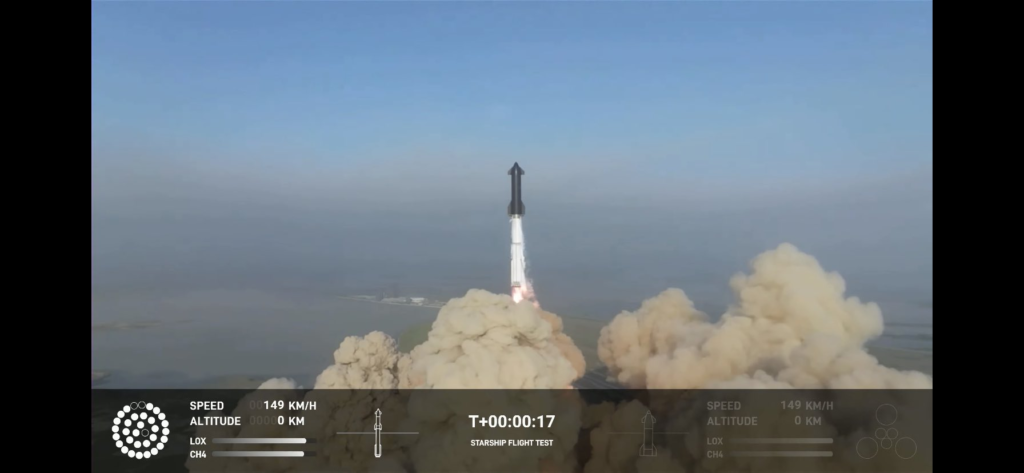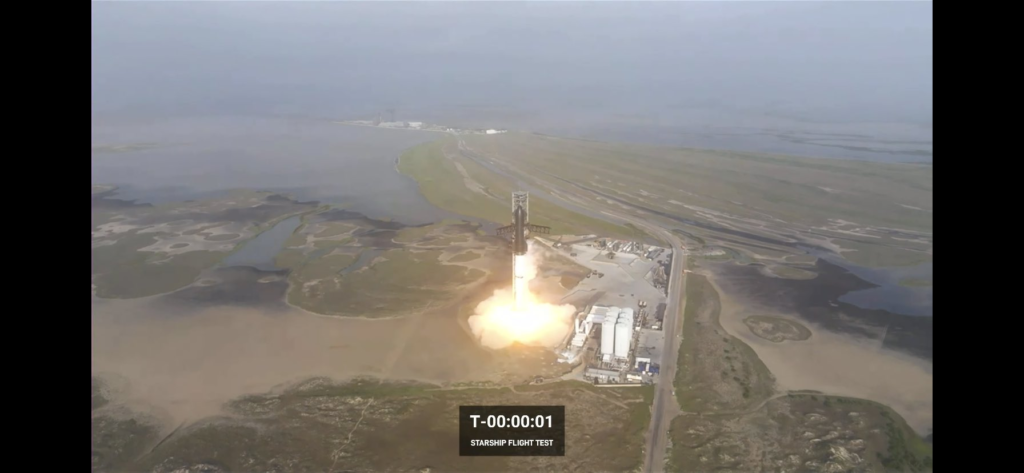
What Happened On SpaceX’s First Starship Launch Attempt?
From Starhopper, to SN5, to the 10km flights, today we finally got to see a full Starship launch attempt, and it did not disappoint. For years now SpaceX has been developing, testing, building, and preparing for this first test flight of Starship. While not perfect, it absolutely cleared the pad and gathered a host of invaluable data for the teams at SpaceX.
With this test now complete, we know the company is headed straight to the drawing board as they prepare for the next attempt with significantly upgraded hardware. Here I will go more in-depth into what happened on this first attempt, where the issues arose, what to expect in the near future, and more.
Starship Launch Profile

By T-1 minute Starship was fully loaded with propellant, the Raptor engines were chilled, and the rocket was preparing for its engine startup sequence. However, seconds later the clock was recycled after the flight director called a hold. Specifically, they decided to hold at T-40 seconds for a few small issues. For one, the booster pressurization was not quite what SpaceX needed which was resolved shortly after it was announced. In addition, the second stage pressurization was a bit off and they were working on some final purging. A few minutes went by before the countdown sequence popped up again and began counting down from 30 seconds.
With 8 seconds left on the count, the Raptor engine startup sequence began and then the engines soon ignited as the clock hit 0. As all the engines began firing, Starship stayed on the pad for around 8 seconds before finally lifting off from the ground. Similar to some original test flights like SN5, you could see debris flying everywhere from the power of the 33 Raptor engines firing so close to the ground. About 14 seconds in and Starship had fully cleared the tower. Around the same time, you could see via the SpaceX-provided flight data that 3 of the Super Heavy Raptor engines were not firing. This included two of the outer ring engines right next to each other and one of the innermost engines. It’s very possible that the significant amount of debris that was shot up after the long engine ignition could have immediately damaged those and other engines. Interestingly enough, Super Heavy does not require every Raptor engine in order to reach orbit, but it can only lose so many.
At this point, Starship continued to accelerate and gain altitude. At T+29 seconds you see a small explosion of what looked like an outer ring Raptor experiencing an anomaly. First, you see debris spread everywhere, and then just a few seconds later a bright flash of lights. Soon after the SpaceX graphic updated and highlighted that another Raptor engine was lost. Despite this, propulsion reported that first-stage engines are nominal. By T+1:18 seconds, the call came out that Starship had reached Max Q, which is the moment of peak mechanical stress on the rocket. At the same time, a zoomed-in shot of the booster from below showed a bright glow coming from in between the engines. Seconds later and the graph updated showing that 6 of the first stage engines were no longer providing thrust. From there the rocket continued to accelerate and we were provided some incredible views looking at the upper stage’s 6 Raptor engines along with the Earth below from an external camera.
By T+2:45, SpaceX was preparing for the booster main engine cutoff. Around the same time, you could see the launch vehicle beginning to spin. At T+2:48 seconds, booster main engine cutoff was announced yet it looked as if the engines continued to fire. Seconds later, the rocket began pointing down as its trajectory was off and it began to lose control. It then managed to complete some acrobatic moves as it continued to spin while losing altitude. Finally, as the rocket got below 30 kilometers in altitude, we saw one large explosion followed by a second. This rapid unscheduled disassembly concluded the first ever full Starship launch attempt.
The full flight profile would have seen Starship separate and the booster perform a flip maneuver. From here the booster would attempt a boost back burn and slow itself down before a controlled splashdown in the Gulf of Mexico. The upper stage on the other hand would have circled the Earth for over an hour after igniting its engines before re-entering the Earth’s atmosphere and impacting the water off the coast of Hawaii. An explosive ending is not the ideal option but it’s a realistic aspect of SpaceX’s methodology. They are building Starship at a rapid pace and nothing provides more information that a real test. Looking in the past it took multiple attempts to before the first successful launch of Falcon 1. This was at the very beginning of SpaceX and almost put the company out of business. Now things have changed yet explosions are still practically guaranteed to happen. With so many rockets lined up the next launch will not be far away at all. Something we can look forward to very soon.
Pad Damage & Next Launch

Overall, the mission was not perfect but definitely successful. Starship cleared the pad and now SpaceX has a bunch of new information they can use for future missions. Arguably, one of the most impressive parts of this launch was the strength of the rocket’s structure and the fact that despite all of the spinning and forces applied to it, it stayed strong until the final explosion. This could mean that the company has some room to tame down the overall Starship build to try and increase its payload capacity even further.
Moving on to possible damages, they could be quite significant. Based on the initial engine ignition debris flying hundreds of feet in the air, the orbital launch mount and parts of the tower likely have some serious damage. This being said, SpaceX put a lot of time and effort into protecting these systems and hardware with some serious metal and general covers. Ideally, the damage is reasonable and can be fixed in a few weeks. The company held off on installing a full water deluge system to save time and get Starship in the air. Images of the aftermath show craters where reinforced concrete once was. This puts in perspective the amount of material that was shot up in the air. A good portion of which probably was sent staring into the Raptor engines at immense speeds. If this was the cause for so many of the Raptor engines failing throughout the mission, it would be a relatively easy fix.
Soon after the mission, Elon Musk tweeted saying, “Congrats @SpaceX team on an exciting test launch of Starship! Learned a lot for next test launch in a few months.” This is great news as we can expect another Starship launch in just a few months. SpaceX also tweeted pointing out, “With a test like this, success comes from what we learn, and today’s test will help us improve Starship’s reliability as SpaceX seeks to make life multi-planetary.”
It’s important to point out that even without the application of any new information gained from this test flight, the next Starship prototype is already much more advanced and upgraded than the rocket we just saw lift off. Days ago Elon was quoted saying, “The funny thing is we are actually dying to get this rocket off no matter what happens to it because there are so many improvements between booster 7 and booster 9, literally hundreds. We moved from hydraulic thrust vector control to electric, the entire heat shield structure is completely redesigned and more.” All of which could be improvements that allow Starship to complete its missions without a hitch. Combine these physical upgrades with lessons learned and the company has a great future opportunity with Starship.
During the live stream, the SpaceX Principal Integration Engineer said, “Now this was a development test. It’s a first test flight of Starship. And the goal is to gather the data and as we said, clear the pad and get ready to go again. So you never know exactly what’s going to happen. But as we promised, excitement is guaranteed. And Starship gave us a rather spectacular end to what was truly an incredible test thus far”. In just days we can expect more information on what happened and how SpaceX is working the problem.
As far as the future of Starship, it’s looking very promising. More and more testing is right around the corner. If the overall future test campaign goes well, actual people could climb aboard Starship for the first time just a few short years from now. Not long ago, NASA selected Starship to be the first crewed lander for its Artemis moon program. Here, the SpaceX vehicle will put astronauts down near the lunar south pole on the Artemis 3 mission, which is targeted to launch in 2025. To add to this, SpaceX has already sold two private around-the-moon Starship missions as well. For example, one mission will fly with a crew of eight artists and influencers. All of which we can hope to see in the coming years.
Conclusion
SpaceX just attempted the first ever integrated test flight of Starship. In the grand scheme of things, the mission was successful as Starship cleared the tower and proceeded to gain invaluable flight data for the next few minutes before a rapid unscheduled disassembly. Already we are hearing that the next full launch will be just a few months away. We will have to wait and see how it progresses and the impact it has on the space industry.
